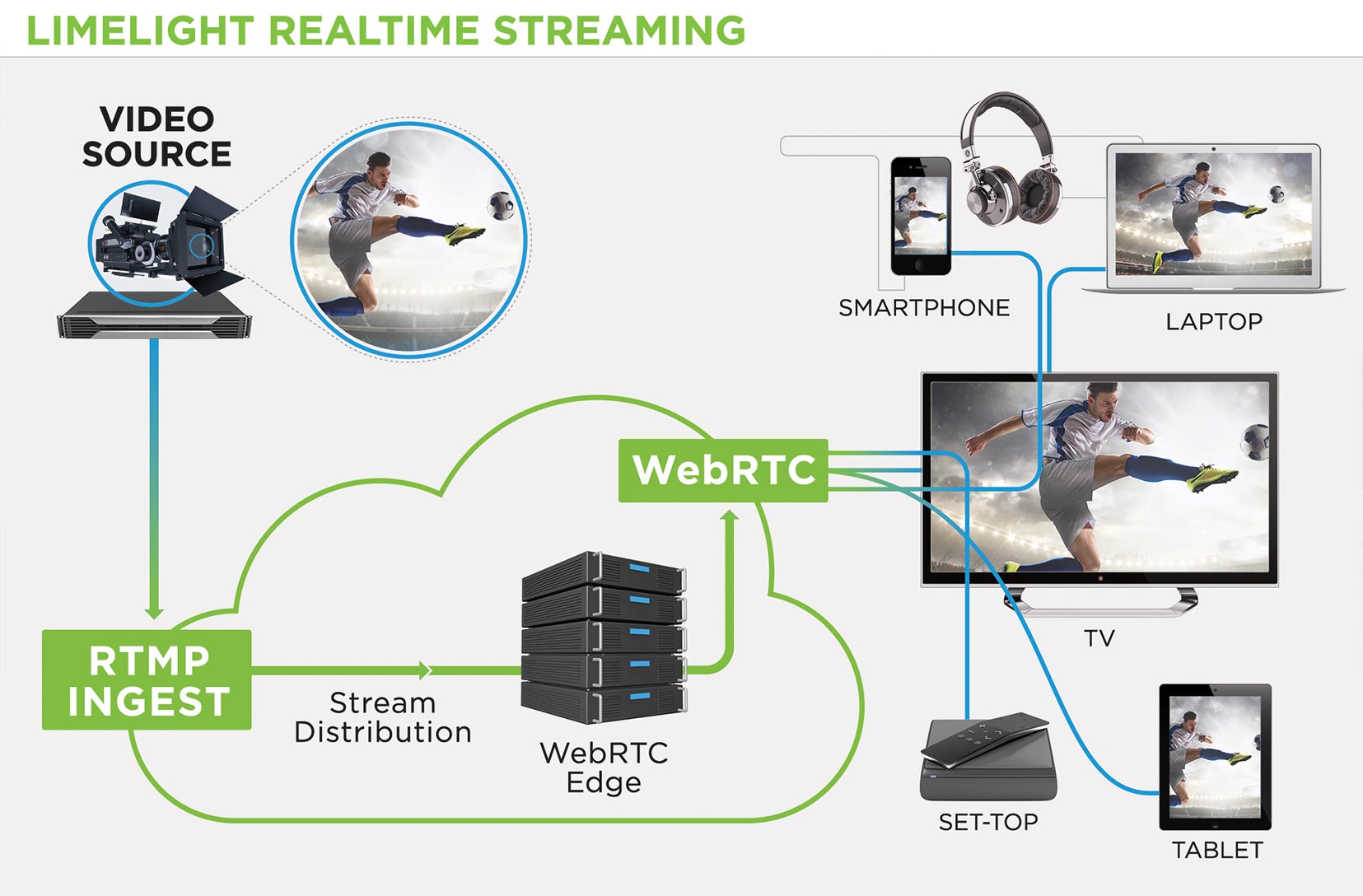라이브 스포츠 및 기타 실시간 이벤트를 시청하는 데 있어 주요 불만 중 하나가 바로 방송 피드와 온라인 스트림 간 지연 현상이 발생한다는 것이다. 이에 라임라이트 네트웍스가 전 세계 어디에서나 시청자들에게 1초 이내에 웹 브라우저로 고품질 비디오를 스트리밍 할 수 있도록 지원하는 솔루션인 ‘라임라이트 리얼타임 스트리밍’을 발표했다. 리얼타임 스트리밍은 업계 표준의 웹 브라우저 기반 통신 방식인 WebRTC 비디오 포맷을 이용하며, UDP를 통해 안정적인 방송 품질의 실시간 비디오 스트리밍을 제공한다. 이로써 영상을 시청하기 전에 비디오 스트림을 청크로 분할하고 버퍼링 할 필요가 없으므로 스트리밍 지연이 발생되지 않는다.
업계 표준 웹 브라우저 기반 통신 방식
WebRTC 비디오 포맷 이용 및 UDP 통해
안정적인 방송 품질 실시간 비디오 스트리밍
라이브 스포츠 및 기타 실시간 이벤트를 시청하는 데 있어 주요 불만 중 하나가 바로 방송 피드와 온라인 스트림 간 지연 현상이 발생한다는 것이다.
실제로 기존의 HTTP 실시간 스트리밍은 비디오 재생 전에 작은 세그먼트 또는 청크로 분할되기 때문에 실시간 스트림은 일반적으로 방송 피드보다 30초 이상의 지연 시간이 발생한다. 청크의 크기를 줄여 지연을 줄일 수도 있지만, 너무 작게 만들면 시청자가 비디오 리버퍼링 및 다른 비디오 재생 문제를 겪게 된다. 스트리밍 레이턴시는 일부 라이브 스트리밍 사용 사례에서는 수용이 가능할 수 있으나, 1초 미만의 레이턴시를 요구하는 실시간 워크플로의 요구 사항을 충족시키지는 못한다. 이로 인해 사용자들이 시청에 불편을 겪게 되고 이를 공개적인 불만으로 드러내는 경우, 기업 명성에 해를 입을 수 있으며, 수익 손실로까지 연결될 수 있다.

라임라이트가 1초 미만 비디오 스트리밍 솔루션인 '라임라이트 리얼타임 스트리밍’을 발표했다
이에 라임라이트 네트웍스가 20일, 전 세계 어디에서나 시청자들에게 1초 이내(Sub-second)에 웹 브라우저로 고품질 비디오를 스트리밍 할 수 있도록 지원하는 솔루션인 ‘라임라이트 리얼타임 스트리밍(Limelight Realtime Streaming)’을 발표했다. 이제 온라인 시청자들도 방송 시청자들과 동시에 영상을 확인하고 즐길 수 있다.
라임라이트 리얼타임 스트리밍은 전 세계 어디에서나 시청자들에게 1초 내에 웹브라우저로 방송 품질과 동일한 고품질 비디오를 스트리밍 할 수 있도록 지원하는 솔루션이다. 리얼타임 스트리밍은 업계 표준의 웹 브라우저 기반 통신 방식인 WebRTC 비디오 포맷을 이용하며, UDP(사용자 데이터 전송 프로토콜)을 통해 안정적인 방송 품질의 실시간 비디오 스트리밍을 제공한다. 이를 통해 영상을 시청하기 전에 비디오 스트림을 청크로 분할하고 버퍼링 할 필요가 없으므로 스트리밍 지연이 발생되지 않는다.
WebRTC(Web Real Time Communication)는 광범위한 웹 브라우저 및 모바일 애플리케이션에서 SSL 보안 실시간 음성, 비디오, 데이터 통신 기능을 지원하는 개방형 표준으로서, 특별한 플러그인이나 사용자 정의 애플리케이션을 사용하지 않아도 주요 웹 브라우저에서 기본적으로 지원되기 때문에 시청자들이 다양한 장치에서 실시간 비디오를 손쉽게 감상할 수 있다. 만약 기업이 사용하는 방화벽이 UDP 트래픽을 차단하도록 설정되어 있어 영상 전송이 어려운 경우에는, TCP 전송을 통해 비디오를 전송할 수 있도록 지원한다.
또 라임라이트 리얼타임 스트리밍은 양방향 데이터 공유 기능을 제공한다. 실제로 라이브 스포츠 경기를 관람하는 시청자들은 자신이 좋아하는 선수에 대한 통계를 받거나, 가장 좋아하는 경기에 투표를 하거나, 보고자 하는 카메라 앵글을 선택할 수 있다. 게임 사용자들은 비디오와 통합된 채팅 채널을 열 수 있고, 온라인 경매를 스트리밍 하여 버튼을 누르는 것만으로 실시간 입찰에 참여할 수 있다. 이러한 양방향 기능은 여러 새로운 비즈니스 기회를 창출한다.
라임라이트 리얼타임 스트리밍의 주요 기능은 다음과 같다.
▲전 세계 어느 곳으로도 1초 내에 비디오를 스트리밍 한다. ▲시청자들이 사용 가능한 대역폭 및 현재 네트워크 상태에서 가능한 최고 화질을 자동으로 수신한다. ▲특정 요구 사항에 맞게 비디오 스트림의 사용자 정의 비트 레이트 및 해상도를 정의할 수 있다. ▲특별한 플러그인 없이도 크롬, 파이어폭스, 사파리, 오페라 (곧 MS 에지 지원 예정) 등의 표준 웹 브라우저에서 라이브 스트림을 시청할 수 있다.
▲라임라이트의 글로벌 사설망은 전 세계 900개 이상의 ISP, 최종 사용자 네트워크 및 PoP에 직접 연결하여 인터넷 정체를 우회한다. ▲대역폭이 떨어지면서 비디오가 멈추는 경우, 오디오 우선 스트리밍을 통해 오디오를 계속 재생할 수 있다. 이전 기존 장치 지원을 위해 RTMP, HLS 비디오 폴백을 사용할 수 있다. ▲비디오 스트림의 다지점(Multipoint) 수집 기능은 백업 위치에 원활한 시스템 대체 작동을 제공하여 복원력을 향상시킨다. ▲시청자의 위치, IP 화이트리스트 및 블랙리스트 제어, URL 토큰화, SSL 암호화를 기반으로 하는 지역 차단 기능을 포함하여 비디오에 대한 액세스를 제한하는 여러 방법을 제공한다.
▲유연한 스케줄링을 위해 프로그래밍 방식의 API 및 셀프 구성 포털을 통해 스트림을 손쉽게 구성, 시작, 중지할 수 있다. ▲CDN 스트림 인증으로 라이브 스트림의 수집을 제한한다. ▲강력한 사용 데이터를 활용하여 전략적 비즈니스 의사결정을 내릴 수 있다. ▲통합 데이터 공유 기능을 통해 시청자에게 실시간 비디오 및 데이터를 제공하는 양방향 애플리케이션을 생성할 수 있고, 투표, 채팅 등과 같은 실시간 피드백을 제공할 수 있다.
라임라이트 리얼타임 스트리밍은 지난 10월 네덜란드 암스테르담에서 열린 미디어, 엔터테인먼트 및 기술 박람회 ‘IBC 2018’에서 전송 부문 ‘TVBEurope 베스트 오브 쇼 어워드(TVBEurope Best of Show Award)’를 수상하여 미디어 콘텐츠 제작, 관리, 전송 부문에서의 성과를 인정받았다.
라임라이트 네트웍스 코리아 박대성 지사장은 “주요 스포츠 경기에 대한 온라인 스트리밍의 인기가 높아지고 있다"라며, "2018 수퍼볼은 310만 건의 라이브 스트림을 기록하며 3년 연속 성장한 반면, TV 방송 시청자 수는 전년 대비 7% 감소했다"라고 말했다.
또 "라임라이트의 “2018 온라인 비디오 현황" 보고서에 의하면, 65% 이상의 시청자들은 방송보다 지연되는 현상이 없다면 스포츠 경기를 더 많이 스트리밍 할 것이라고 답했다"라며, "스트리밍 레이턴시 문제가 해결된다면 스포츠 경기 외에도 온라인 겜블, e스포츠, 비디오 게임을 포함하여 다른 온라인 라이브 비디오 사용 사례도 늘어날 것이다”라고 설명했다.
박대성 지사장은 “라임라이트 리얼타임 스트리밍은 방송사 및 기타 기업들이 표준 웹 브라우저를 통해 시청자들에게 진정한 실시간 스트리밍 서비스를 제공할 수 있도록 지원하여 실시간 온라인 스트리밍에 대한 시청자들의 주요 불만사항을 해결한다”라며, “리얼타임 스트리밍의 주목할 만한 사항은 실시간 양방향 데이터 기능을 제공하여 시청자 참여를 높이고 방송사들이 라이브 스트림을 수익화할 수 있는 새로운 기회로 활용할 수 있다는 것이다”라고 덧붙였다.
